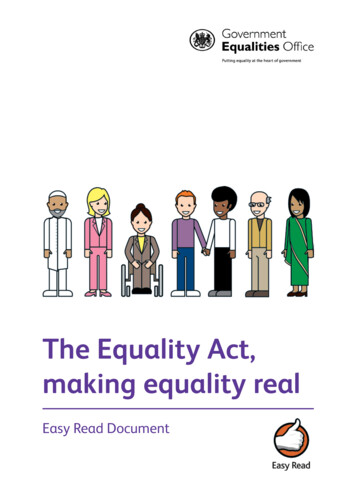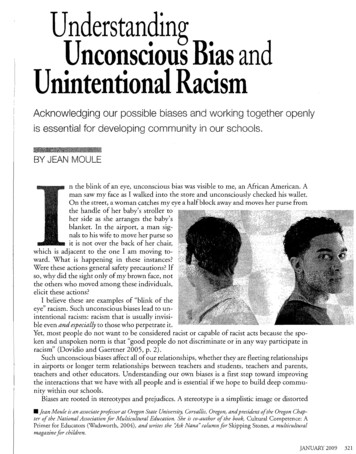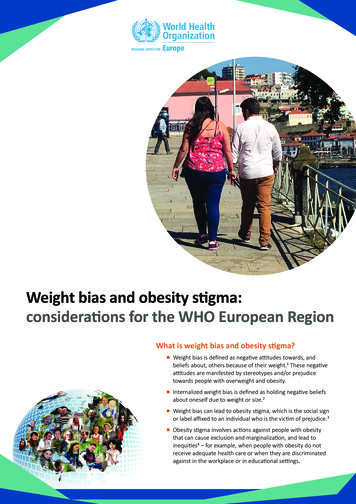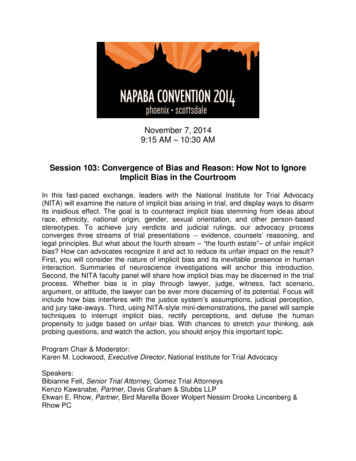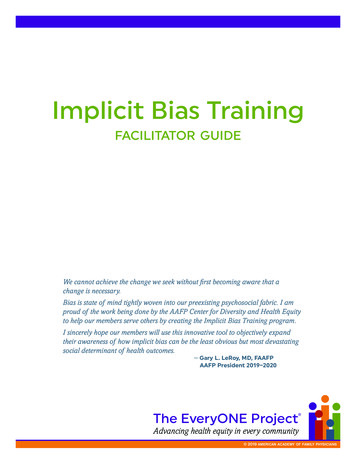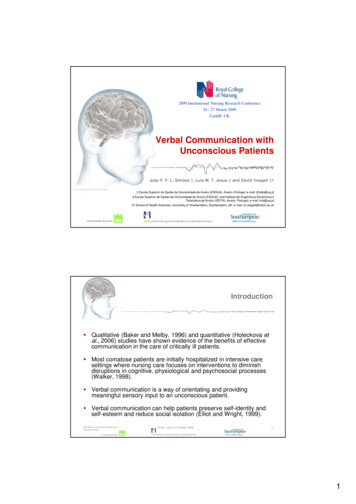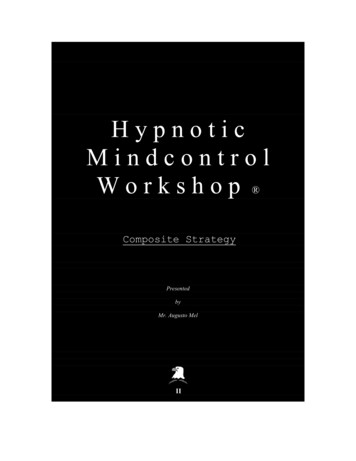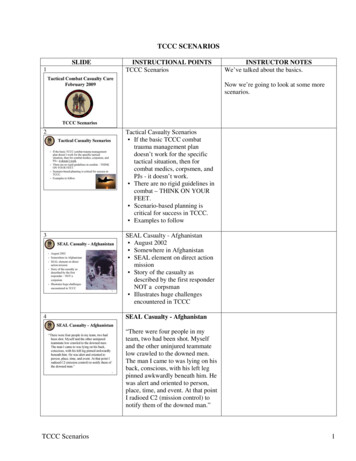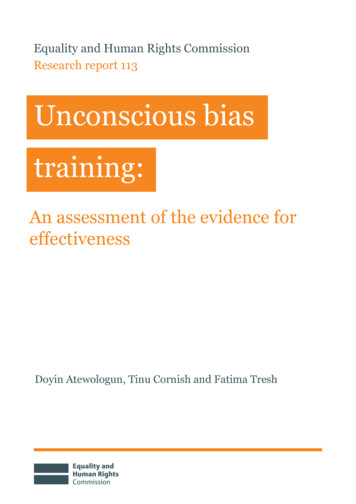
Transcription
Equality and Human Rights CommissionResearch report 113Unconscious biastraining:An assessment of the evidence foreffectivenessDoyin Atewologun, Tinu Cornish and Fatima Tresh
2018 Equality and Human Rights CommissionFirst published March 2018ISBN: 978-1-84206-720-8Post:Research TeamEquality and Human Rights CommissionArndale HouseThe Arndale CentreManchester M4 ights.com0161 829 8500www.equalityhumanrights.comYou can download a copy of this report as a PDF from our website:www.equalityhumanrights.comEqualityand thisHumanRights inCommissionResearchReportSeriestheIf you requirepublicationan alternativeformat, pleasecontactCommunicationsdiscussyour needsResearchat:The Equality and TeamHumantoRightsCommissionReport Series earch carried out for the Commission by commissioned researchers.The views expressed in this report are those of the authors and do not necessarilyrepresent the views of the Commission. The Commission is publishing the reportas a contribution to discussion and debate.Please contact the Research Team for further information about other Commissionresearch reports, or visit our website.
ContentsAcknowledgements . 3Executive summary . 41 Introduction. 101.1What is unconscious bias training? . 101.2An assessment of UBT and its effectiveness . 111.3Scope of the assessment . 121.4Methodology. 132 Key findings . 152.1Can unconscious bias training meet its aims? . 152.2Back-firing effects of UBT. 192.3Summary . 213 Design considerations of UBT . 233.1Contextual factors . 233.2Design characteristics . 253.3Summary . 324 Applying UBT to protected characteristics . 334.1Evidence for protected characteristics . 334.2Summary . 355 Conclusion. 365.1Main findings . 365.2Further research. 385.4Recommendations . 40References . 44Appendix 1 Methodology . 50Appendix 2 Additional Sources. 57Contacts . 652
AcknowledgementsThe authors (who contributed equally to this report) would like to thank Pete Jonesand Rob Briner for their helpful feedback. Thanks also to our partners at the Equalityand Human Rights Commission, Kathleen Jameson, Rosie Wallbank and DavidPerfect. Thank you to the Equality Challenge Unit (ECU) for supporting TinuCornish’s involvement in the review.3
How effective is unconscious bias training? An assessment of the evidenceExecutive summaryExecutive summaryIn her 2017 review, ‘Race in the Workplace’, Baroness McGregor-Smith highlightedthe ‘structural, historical bias’ that prevents ethnic minorities, women, disabledpeople and others from progressing in their careers. She recommended that the UKGovernment create a free, online unconscious bias training (UBT) resource to tacklethe unconscious bias that she described as ‘much more pervasive and moreinsidious than the overt racism that we associate with the 1970s’ (McGregor-Smith,2017, p.2).Prior to the McGregor-Smith review, and as a direct consequence of it, an increasingnumber of organisations in the UK have introduced UBT. This training has beenimplemented even though some academic research and reports have highlighted theineffectiveness, and even the negative effects, of UBT. Additionally, there remainsmuch academic debate about the accuracy of the Implicit Association Test (IAT) (areaction-time measure of how quickly a participant can link positive and negativestimuli to labels such as ‘male’ or ‘female’), which is the most common measure ofunconscious bias.The Equality and Human Rights Commission (‘the Commission’) seeks to contributeto UK debate and policy on the use of UBT to counter workplace inequalities. Thisreport was commissioned to identify and evaluate available evidence to helpdetermine whether, when and how UBT works. It consisted of a rapid evidenceassessment methodology. This required a transparent and systematic approach tothe search for evidence and the elimination of studies that did not meet pre-specifiedminimum quality standards.The research question that this assessment aimed to address was: What is the evidence for the effectiveness of unconscious bias training?What is unconscious bias training?Unconscious (or implicit) biases, unlike conscious biases, are the views and opinionsthat we are unaware of; they are automatically activated and frequently operate4
How effective is unconscious bias training? An assessment of the evidenceExecutive summaryoutside conscious awareness and affect our everyday behaviour and decisionmaking. Our unconscious biases are influenced by our background, culture, contextand personal experiences.Primarily, UBT aims to increase awareness of unconscious bias and its impact onpeople who belong to groups denoted as having ‘protected characteristics’ under theEquality Act 2010 (age, race, sex, disability, religion or belief, gender reassignment,sexual orientation, marriage and civil partnership, pregnancy and maternity). Otheraims are to: reduce implicit/unconscious bias towards members of a group denotedas having a ‘protected characteristic’; reduce explicit bias towards members of agroup denoted as having a ‘protected characteristic’; and change behaviour, in theintended direction, towards equality-related outcomes.UBT is often delivered online to an individual participant or face-to-face as aworkshop to a group of participants. Although each experience is different, most UBTinterventions include one or more of the following: An unconscious bias ‘test’ (a reaction-time measure of how quickly aparticipant can link positive and negative stimuli to labels such as ‘male’ or‘female’; the most common example is the IAT). An unconscious bias ‘test’ debrief (an explanation of the participants’unconscious bias ‘test’ results). Education on unconscious bias theory. Information on the impact of unconscious bias (via statistics/illustrativeexamples). Suggested techniques for either reducing the level of unconscious bias ormitigating the impact of unconscious bias (without altering or reducing thestrength of the bias). For example, bias reduction strategies, such as exposingparticipants to counter-stereotypic exemplars, can reduce the level ofunconscious bias; bias mitigation strategies, such as blind review in selectionand assessment, can reduce the impact of unconscious bias.Key findingsOverall, our evaluation of rigorous studies on the effectiveness of UBT indicates amixed picture and a need for further research to determine the effectiveness ofunconscious bias training. We found that: UBT is effective for awareness raising by using an IAT (followed by a debrief)or more advanced training designs such as interactive workshops.5
How effective is unconscious bias training? An assessment of the evidenceExecutive summary UBT can be effective for reducing implicit bias, but it is unlikely to eliminate it. UBT interventions are not generally designed to reduce explicit bias and thosethat do aim to do so have yielded mixed results.Using the IAT and educating participants on unconscious bias theory is likelyto increase awareness of and reduce implicit bias. The evidence for UBT’s ability effectively to change behaviour is limited. Mostof the evidence reviewed did not use valid measures of behaviour change. There is potential for back-firing effects when UBT participants are exposed toinformation that suggests stereotypes and biases are unchangeable. Evidence from the perspective of the subjects of bias, such as those withprotected characteristics, is limited. This evidence could provide additionalinformation on potential back-firing effects. Awareness raisingThe assessment indicates that awareness raising is the most likely aim of UBT andthe aim most often achieved. Unconscious biases can be measured by a test suchas the IAT. The evidence suggests that increasing the sophistication of UBT (forexample by delivering an interactive workshop) can increase both participantawareness of their own implicit bias and concern about wider discrimination, and thisawareness will continue to increase over time.Reducing implicit biasThere is evidence that UBT reduces implicit bias, however, these biases are unlikelyto be completely eradicated. When measured after the UBT, participants’ scores onIATs are reduced but do not fall to neutral. Evidence suggests that moresophisticated UBT, such as those that combine awareness of unconscious bias,concern about its effects and the use of tools to reduce bias, can reduceunconscious bias up to eight weeks post-intervention.Reducing explicit biasExplicit bias change (shifting the attitudes and beliefs we have about a person orgroup on a conscious level) is harder to achieve through UBT than implicit bias. Theevidence indicates three primary reasons for this:6
How effective is unconscious bias training? An assessment of the evidenceExecutive summary People tend to believe that they do not hold explicit prejudiced attitudes. Training participants who do hold explicit prejudiced attitudes are unlikely todisclose this. This is referred to as ‘social desirability bias’. Most UBT interventions do not appear to be designed to alter or challengeexplicit bias levels.Changing biased behaviourEvidence of behaviour change as an outcome of UBT is limited. Behaviour change isdifficult to operationalise and measure, and therefore the evidence is harder togather. For example, self-report measures of behavioural intentions are oftendescribed in studies, even though they do not actually tell us whether behaviour didchange as a result of UBT.Recommendations for practiceThe evidence reviewed suggests that organisations should undertake a range ofapproaches to maximise the effectiveness of their UBT interventions.Think about both UBT content and contextThe content of a UBT intervention can influence its success in meeting its aim/aims.We recommend that organisations: Use an IAT, followed by a debrief session, to increase awareness ofunconscious bias and to measure any changes in implicit bias.Deliver training to groups of people who work closely together (for exampleteams).Educate participants about unconscious bias theory rather than just providinginformation about the impact of unconscious bias using statistics.Include bias reduction strategies (such as promoting counter-stereotypicexemplars to challenge implicit stereotype endorsement and its effects) andbias mitigation strategies (such as more rigorous use of structured interviewsto minimise the impact of bias), so that participants feel empowered to dosomething about unconscious bias.7
How effective is unconscious bias training? An assessment of the evidenceExecutive summaryEvaluate to measure effectivenessWe recommend that organisations: Are clear on the aim/aims of their UBT and use before-and-after measures toassess changes in, for example, awareness raising or attitude change. Randomly assign matched participants to intervention and control groups toevaluate the effectiveness of the training, and deliver the training to controlparticipants once effectiveness has been established. Always carry out an evaluation after a UBT intervention to establish whether ithas been effective in meeting its intended aim/aims.Valid measures should be used to assess the effectiveness of the training. Forexample, if UBT has been designed for behaviour change, the evaluation shouldmeasure actual changes in behaviour, as opposed to behavioural intentions. Theneed for consistent and valid metrics for all aims of UBT is discussed in the ‘furtherresearch’ section.See UBT as part of a wider programmeFinally, organisations should be aware of the limitations of UBT (including potentialback-firing effects) and challenge underlying assumptions that raising awareness ofunconscious bias or achieving short-term changes in implicit bias in isolation canlead to long-term change at an organisation level. For organisational level change tohappen, organisational structures, policies and procedures must be targeted directly,perhaps overhauled. If the aim of UBT is to have an impact on company practice andemployee behaviour to foster inclusive cultures where everyone meets their potentialregardless of their identities (PwC, 2016; Nelson, 2017), UBT should be treated asjust one part of a comprehensive strategy for achieving organisation-wide change.Policy implicationsOverall, this assessment is intended to promote better informed and evidence-basedapproaches to reducing inequalities in organisations, by interrogating theeffectiveness of UBT. The findings raise the following questions about what rolepolicy makers, government and employers should play in response to the findings:1. Should a standard syllabus be compiled for the content of UBT?2. Should the UK Governments and UBT experts work to develop astandardised set of methods for delivering UBT?8
How effective is unconscious bias training? An assessment of the evidenceExecutive summary3. Should the UK Governments and UBT experts develop a nationally agreedmetric or outcome measure to evaluate the effectiveness of diversity andinclusion initiatives, including UBT?4. Should a ‘What Works’ network be created for the equality, diversity andinclusion agenda, within which UBT will comprise one strand?Further researchThe assessment found that only 18 sources of evidence were both relevant to theresearch question and adopted the minimum standards for quality research. Thenumber of rigorous studies assessing the effectiveness of UBT is small and this is asignificant finding in itself. More UK-based research and evaluations are required tostrengthen the evidence base; further research should: systematically compare the impact of context (for example, organisations’strategic approaches to diversity), design characteristics (that is, the trainingcontent and delivery methods used), and effectiveness in reducing biastowards specific groups, and ensure valid measures of UBT aims (for example, adopt measures thatassess actual behaviour change as opposed to asking participants about theirintentions to change using questionnaires), with the aim of developingconsistent and valid metrics for all aims of UBT, including awareness raising,implicit bias change, explicit bias change and behaviour change.9
How effective is unconscious bias training? A review of the evidenceIntroduction1 Introduction1.1What is unconscious bias training?Unconscious (or implicit) biases, unlike conscious biases, are the views and opinionsthat we are unaware of (Cornish and Jones, 2013); they are automatically activatedand frequently operate outside conscious awareness (Lai et al., 2013) and affect oureveryday behaviour and decision making (Kahneman, 2011). Our unconsciousbiases are influenced by our background, culture, context and personal experiences.Workplace ‘Unconscious Bias Training’ (UBT) is a term used to describe a session,programme or intervention in which participants learn about unconscious bias,typically with a view to reducing the negative impact of bias on organisationalpractice and individual behaviour. UBT generally, although not exclusively, teachesemployees about the negative impact of biases on people with protectedcharacteristics, such as women or ethnic minorities. It is widely accepted that makingpeople aware of their (unconscious) biases is the first step towards addressing themanifestation of them (Lee, 2017; Devine et al., 2012).Unconscious biasUBT is often designed, developed and modified on the basis of the large body ofresearch on unconscious bias. During everyday interactions, our brains receive aninflux of information. Unconscious biases arise because we rely on ‘short-cuts’ tofilter this information rapidly. The function of these short-cuts, or heuristics, is tocategorise and make decisions about people and tasks efficiently.One of the negative consequences of this automatic processing is the influence ofsocial stereotypes on our decision making. There is ample research documenting theinfluence of stereotypes on workplace evaluations and decision making (for exampleEagly and Karau, 2002; Correll, 2017; Kossek et al., 2017), leading to detrimentaloutcomes for women, ethnic minorities, disabled people and others with a protectedcharacteristic.10
How effective is unconscious bias training? A review of the evidenceIntroductionThe aim of trainingGiven the negative impact of stereotypes on outcomes relating to equality, diversityand inclusion in the workplace, UBT is designed to increase awareness ofunconscious bias through instruction. Participants learn that even where they do notconsciously endorse a stereotype; it can influence their attitudes and behaviouroutside their awareness. In addition to awareness raising, the aim of training is toteach methods to alleviate unconscious bias (Girod et al., 2016).Organisations’ ultimate purpose in implementing unconscious bias interventionssuch as training is to reduce or remove objective workplace inequalities (Nelson,2017). However, the belief that UBT can achieve this rests on the underlyingassumptions that: (1) such inequalities are caused, at least in part, by the behaviourof everyone in the organisation (rather than just those responsible for managing theorganisation); that (2), changing or addressing biases and attitudes will changebehaviour; and that (3) changing individual behaviour will change organisationaloutcomes. Furthermore, this causal chain assumes that organisations expectindividuals will change their behaviour and that these variations will lead toorganisational transformation even when organisational culture or climate do notreinforce the altered behaviour or may even counter the effect. Thus, whenevaluating the evidence about UBT, it is important to bear in mind the causalassumptions underlying its popular adoption by organisations. It is also importantfrom an evidence-based practice perspective to analyse evidence for the problemfirst and only then consider evidence for possible solutions (Atewologun, Cornish &Briner, 2017).Overall, our search for evidence reveals that there are very few evaluations of UBT.This makes it difficult to assess the efficacy of current approaches. Furthermore, littleis known about how UBT design and delivery affects its effectiveness. For example,although theoretical frameworks point to best practice UBT design (for exampleMoss-Racusin et al., 2014) to maximise organisational change (for example Nelson,2017), an evaluation of these design features has not yet been conducted.1.2An assessment of UBT and its effectivenessThis assessment was commissioned by the Commission in 2017 to shed light on theevidence available for the effectiveness of UBT.11
How effective is unconscious bias training? A review of the evidenceIntroductionIncreasing use of UBT in UK workplacesIn her 2017 review, ‘Race in the Workplace’, Baroness McGregor-Smith highlightedthe ‘structural, historical bias’ that prevents ethnic minorities, women, disabledpeople and others from progressing in their careers. She recommended that the UKGovernment create a free, online unconscious bias training resource to tackle theunconscious bias that she describes as ‘much more pervasive and more insidiousthan the overt racism that we associate with the 1970s’ (McGregor-Smith, 2017, p.2).In its official response to Baroness McGregor-Smith, the UK Government highlightedits increased use of UBT in the Civil Service (Business, Energy and IndustrialStrategy, 2017). Private sector organisations have also implemented UBT inincreasing numbers. Case studies analysed for this assessment indicate that tens ofthousands of leaders and staff have undertaken the training nationally andinternationally through in-house and online UBT programmes.The rising number of organisations adopting unconscious bias training warrants aninvestigation into its usefulness. This is particularly necessary given that numerousreports have questioned the usefulness of UBT (Noon, 2018; Moss-Racusin et al.,2014; Kalev et al., 2006). Research has also suggested that UBT can even activatenegative stereotypes or elicit negative reactions (Rudman and Glick, 2001; Dobbin etal., 2015).Aims of the assessmentThis assessment aims, first, to bring to light the evidence for the effectiveness ofUBT, specifically meeting its declared aims. These aims are: awareness raising;implicit bias change; explicit bias change; and behaviour change.Second, the assessment analyses the evidence to identify the boundary conditionswithin which UBT is deemed effective. Relatedly, evidence of when UBT may be lesseffective or, in fact have a negative impact, is required. Finally, this assessment aimsto highlight the evidence gaps that will provide a pathway for further research.1.3Scope of the assessmentThis assessment aims to inform the Commission’s response to recommendations toimplement UBT across the UK.To meet the aims of this assessment, the broad research question is ‘What is theevidence for the effectiveness of unconscious bias training (UBT)?’12
How effective is unconscious bias training? A review of the evidenceIntroductionWhat is ‘effectiveness’?We refer to the ‘effectiveness’ of UBT in meeting its stated aims. Therefore, theeffectiveness of the training interventions evaluated is dependent on the aims as setout (explicitly or inferred) by the training designer. A training intervention is deemedeffective if robust evidence is provided that the intended aim/aims have been met asa result of the training. The assessment seeks to describe what works with regard toUBT, by summarising and analysing the evidence for what, how and for whom UBTis effective.1.4MethodologyA rapid evidence assessment was conducted (Figure 1.1). The three-stage processof collecting, evaluating and analysing the evidence is summarised here and detailedfurther in Appendix 1.Figure 1.1 Methodology for rapid evidence assessmentIdentify theevidence fromonline databasesAcademicsearches (i.e.published peerreviewed articles)(N 57)Non-academicsearches (i.e.reports) (N 31)Evaluate the qualityof the evidenceEvidenceevaluated usingthe MarylandScale of ScientificMethodsSourcesidentified as lowon rigour areexcludedAnalyse theevidenceIdentify the aimsand design of theinterventionDrawconclusions aboutoutcomesReview andreport onevidencegathered (N 18)To assess the methodological quality of the evidence, we used the Maryland Scaleof Scientific Methods (MSSM) as recommended by the Civil Service in the RapidEvidence Assessment Toolkit (Civil Service, 2014). For inclusion in this assessment,we selected studies that reached a minimum level of 2 according to the MSSM(Table 1.1; see Appendix 1 for further information).13
How effective is unconscious bias training? A review of the evidenceTable 1.1IntroductionAssessment sources by level of rigourMaryland Scale of Scientific Methods Level2 – slightly rigorous3 – moderately rigorous4 – very rigorous5 – extremely rigorousNumber of sources716414
How effective is unconscious bias training? A review of the evidenceKey findings2 Key findings2.1Can unconscious bias training meet its aims?As described in Chapter 1, this rapid evidence assessment sets out to evaluate theevidence for the effectiveness of unconscious bias training (UBT), where‘effectiveness’ is determined as the extent to which UBT meets one or more of thefour stated aims of training, as identified from the studies reviewed. This chapterconsiders the evidence that UBT is effective for a) awareness raising, b) implicit biaschange, c) explicit bias change and d) behaviour change. In Boxes 1 to 4, wedescribe studies that are exemplars of each area of UBT aims.Raising awareness of biasEleven of the studies used in this assessment explicitly stated that the aim of theUBT intervention was to raise awareness of unconscious bias. Hausmann et al.(2014) and Capers et al. (2017) showed self-reported increased awareness ofunconscious bias after a UBT intervention. Further, Moss-Racusin et al. (2016) foundan increase in participants’ knowledge about diversity issues after their participationin a UBT workshop. Notably, this study did not measure bias awareness throughmere self-report but through participants’ heightened ability to detect accurately thegender diversity of their environment. We conclude that UBT interventions canincrease awareness of bias.Box 1. Awareness raising(This study was rated at Maryland Scale of Scientific Methods (MSSM) Level 2,‘slightly rigorous’)In one US study, Whatley (2018) used an Implicit Association Test (IAT) andimplemented a ‘bias literacy workshop’ (Carnes et al., 2012) to assess theeffectiveness of UBT on multi-disciplinary staff team members for awareness raisingand behaviour change towards African American students in special education. Thebias literacy workshop involved educating participants on the theory of unconsciousbias and teaching strategies to mitigate bias. Using a pre- and post-test design,15
How effective is unconscious bias training? A review of the evidenceKey findingsWhatley measured participants’ scores on ‘objectivity’ and ‘teacher expectations’.Results showed significant differences on both measures, indicating that staffincreased awareness of their vulnerability to bias (objectivity measure) and had morepositive expectations of individual students following the UBT intervention (teacherexpectations measure).Changing implicit biasEleven of the sources used in this assessment explicitly stated that the aim of theUBT intervention was to change implicit bias. Leslie et al.’s (2017) study found areduction in implicit bias for second year medical students post-intervention (thoughthis did not happen for first year students), and reductions for sexual orientationpreference and racial preference (but not weight preference). Carnes et al. (2015)found no significant change in IAT scores after their unconscious bias workshop.However, Girod et al. (2016) found a reduction in implicit gender bias across allgroups, including for men and older participants who held stronger biases. Further,Devine et al. (2012) found reduced race-IAT scores eight weeks after a habitbreaking intervention. This intervention is based on the premise that unconsciousbias is like a habit that can be reduced through a combination of awareness ofunconscious bias, concern about its effects, and the use of tools to reduce bias.We conclude that there is mixed evidence for the effectiveness of UBT for reducingimplicit bias. The results reported by Leslie et al. and Girod et al. suggest that UBTinterventions can reduce the strength of the bias; however, we found no evidence toshow that UBT can reduce bias to the extent that there is ‘neutral’ preference.Box 2. Awareness raising and implicit bias change(This study was rated at MSSM Level 2, ‘slightly rigorous’)Girod et al. (2016) evaluated the impact of a 20-minute educational presentation onreducing gender bias in 281 faculty members from 13 clinical departments at StanfordUniversity in the US. The study used pre- and post-test measures. Pre-interventionimplicit measures (using the IAT) showed a slight preference for men in leadershippositions (this bias was stronger in male, compared with female, participants, andolder, compared with younger, participants). All racial groups showed the sameextent of implicit gender bias pre-intervention. The implicit preference for men inleadership reduced immediately post-intervention, at statistically significant levelsacross gender, age and race. However, male and older participants still had strongerimplicit biases.16
How effective is unconscious bias training? A review of the evidenceKey findingsChanging explicit biasNine of the sources used in this assessment measured e
and personal experiences. Primarily, UBT aims to increase awareness of unconscious bias and its impact on people who belong to groups denoted as having 'protected characteristics' under the Equality Act 2010 (age, race, sex, disability, religion or belief, gender reassignment,

